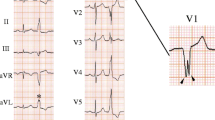Abstract
Background
The aim of the study was to determine the long-term reliability of atrioventricular and intraventricular conduction and the implications for cardiac resynchronization therapy (CRT-D) following catheter ablation of bundle branch reentry tachycardia (BBRT) and interfascicular tachycardia.
Methods and results
Fourteen patients with recurrent monomorphic ventricular tachycardia (VT) (n = 11) and incessant VT (n = 3) underwent catheter ablation of BBRT (n = 7), interfascicular tachycardia (n = 5) or both arrhythmias (n = 2). Successful ablation was achieved in all patients without intraprocedural atrioventricular (AV) block. Within 2 months after ablation, three patients with BBRT and pre-existing prolonged QRS developed a delayed third-degree AV block. During the follow-up of 2 years, two patients with interfascicular tachycardia developed a new left bundle branch block (LBBB) associated with worsening of heart failure. Three patients underwent upgrading of implantable cardioverter defibrillator therapy to CRT-D early after ablation which improved heart failure during the 6 months follow-up. During the long-term follow-up of 39 ± 13 months, VT storm recurred in one patient. Four of the 14 patients died of deterioration of heart failure and one had to undergo heart transplantation.
Conclusions
Catheter ablation for BBRT in patients with prolonged QRS is associated with a high risk of delayed third-degree AV block. Ablation of interfascicular tachycardia can be associated with delayed LBBB. After ablation of bundle branch reentry, patients with prolonged QRS are candidates for cardiac resynchronization therapy but the mortality remains high.





Similar content being viewed by others
References
Tchou P, Mehdirad AA (1995) Bundle branch reentry ventricular tachycardia. Pacing Clin Electrophysiol 18:1427–1437
Blanck Z, Dhala A, Desphande S, Sra J, Jazayeri M, Akthar M (1993) Bundle branch re-entrant ventricular tachycardia: cumulative experience in 48 patients. J Cardiovasc Electrophysiol 4:253–264
Cohen TJ, Chien WW, Lurie KG, Yong C, Goldberg HR, Wang YS, Langberg JJ et al (1991) Radiofrequency catheter ablation for treatment of bundle branch re-entrant ventricular tachycardia: results and long-term follow-up. J Am Coll Cardiol 18:1767–1773
Simons GR, Sorrentino RA, Zimerman LI, Wharton JM, Natale A (1996) Bundle branch reentry tachycardia and possible sustained interfascicular reentry tachycardia with a shared unusual induction pattern. J Cardiovasc Electrophysiol 7:44–50
Crijns HJ, Smeets JL, Rodriguez LM, Meijer A, Wellens HJ (1995) Cure of interfascicular re-entrant ventricular tachycardia by ablation of the anterior fascicle of the left bundle branch. J Cardiovasc Electrophysiol 6:486–492
Reithmann C, Hahnefeld A, Oversohl N, Ulbrich M, Remp T, Steinbeck G (2007) Reinitiation of ventricular macroreentry within the His-Purkinje system by back-up ventricular pacing—a mechanism of ventricular tachycardia storm. Pacing Clin Electrophysiol 30:1–11
Reithmann C, Hahnefeld A, Remp T, Steinbeck G (2007) Ventricular tachycardia with participation of the left bundle-Purkinje system in patients with structural heart disease: identification of slow conduction during sinus rhythm. J Cardiovasc Electrophysiol 18:808–817
Reithmann C, Hahnefeld A, Ulbrich M, Matis T, Steinbeck G (2009) Different forms of ventricular tachycardia involving the left anterior fascicle in nonischemic cardiomyopathy: critical sites of the re-entrant circuit in low-voltage areas. J Cardiovasc Electrophysiol 20:841–849
Stevenson WG (2005) Catheter ablation of monomorphic ventricular tachycardia. Curr Opin Cardiol 20:42–47
Cleland JGF, Daubert JC, Erdmann E, Freemantle N, Gras D, Kappenberger L, Tavazzi L, for the Cardiac Resynchronization-Heart Failure (CARE-HF) Study Investigators (2005) The effect of cardiac resynchronization on morbidity and mortality in heart failure. N Engl J Med 352:1539–1549
Ritter P, Padeletti L, Dellnoy PP, Garrigue S, Silvestre J (2004) AV delay optimisation by peak endocardial acceleration in cardiac resynchronization therapy. Comparison with standard echocardiographic procedures. Europace 6(Suppl. 1):209
Breithardt LA, Stellbrink C, Franke A, Balta O, Diem BH, Bakker P, Sack S (2002) Acute effects of cardiac resynchronization therapy on left ventricular Doppler indices in patients with congestive heart failure. Am Heart J 143:34–44
Abraham WT, Gras D, Yu CM, Guzzo L, Gupta MS, FREEDOM Steering Committee (2010) Rationale and design of a randomized clinical trial to assess the safety and efficacy of frequent optimation of cardiac resynchronization therapy: the Frequent Optimzation Study Using the QuickOpt Method (FREEDOM) trial. Am Heart J 159:944–948
Narasimhan C, Jazayeri M, Sra J, Dhala A, Desphande S, Biel M, Akhtar M et al (1997) Ventricular tachycardia in valvular heart disease: facilitation of sustained bundle-branch reentry by valve surgery. Circulation 96:4307–4313
Mehdirad AA, Keim S, Rist K, Tchou P (1995) Long-term clinical outcome of right bundle branch radiofrequency catheter ablation for treatment of bundle branch re-entrant ventricular tachycardia. Pacing Clin Electrophysiol 18:2135–2143
Willems S, Borggrefe M, Shenasa M, Chen X, Haverkamp W, Hindricks G, Wietholt D et al (1992) Percutaneous high frequency current catheter ablation in permanent ventricular tachycardia of the “bundle branch reentry” type after implantation of an automatic cardioverter defibrillator. Z Kardiol 81:486–491
Dickstein K, Vardas PE, Auricchio A, Daubert JC, Linde C, McMurray J, Ponikowski P et al (2010) Focused update of ESD guidelines on device therapy in heart failure. Eur Heart J 31:2677–2687
Schmidt B, Tang M, Chun KRJ, Antz M, Tilz RR, Metzner A, Koektuerk B et al (2009) Left bundle branch-Purkinje system in patients with bundle branch re-entrant tachycardia: lessons from catheter ablation and electroanatomic mapping. Heart Rhythm 6:51–58
Conflict of interest
The authors declare that they have no conflict of interest.
Author information
Authors and Affiliations
Corresponding author
Rights and permissions
About this article
Cite this article
Reithmann, C., Herkommer, B., Huemmer, A. et al. The risk of delayed atrioventricular and intraventricular conduction block following ablation of bundle branch reentry. Clin Res Cardiol 102, 145–153 (2013). https://doi.org/10.1007/s00392-012-0509-2
Received:
Accepted:
Published:
Issue Date:
DOI: https://doi.org/10.1007/s00392-012-0509-2




